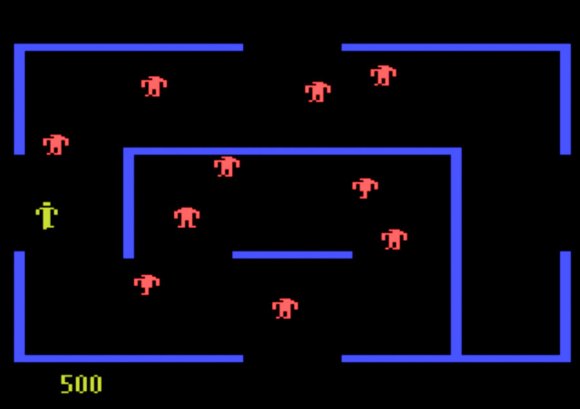Results 1 to 1 of 1
-
July 21st, 2013, 21:45 #1Won Hung Lo













- Join Date
- Apr 2003
- Location
- Nottingham, England
- Age
- 54
- Posts
- 141,803
- Blog Entries
- 3209
- Rep Power
- 50
 How the mazes were generated for classic Berzerk game
How the mazes were generated for classic Berzerk game

This is a screenshot from the Atari 5200 version of the classic game Berserk. But the write-up we’re featuring actually looks at the original coin-op version. The maze for each level was established on the fly using a seed number fed into a rudimentary algorithm . Here’s a close look at how the maze building code actually worked.
Recently we saw a talk by Pitfall creator [David Crane] as part of our Retrotechtacular series. That is a real gem of programming history, and one of our favorite take-aways was that the levels were not hardcoded, but built using a random number generator algorithm with a hardcoded seed (so that the game was the same each time you played it). This uses a similar method but with a somewhat random seed.
The maze building was reverse engineered by observing the game in a MAME emulator, and by digging through disassembled code. Each time the code is “cold started” the seed starts out at zero, but from there the room number is used as the next seed. This is fed through a very simple algorithm. It generates directions for the walls, which use s few bit-wise operations to add the pillars inside the rooms.
It’s a great thing to study if you’re writing games for your embedded projects. By generating the room programmatically you don’t use up as much program memory. Of course these days even simple hobby controllers have way more storage to work with than [Alan McNeil] had when he designed Berserk.
http://hackaday.com/2013/07/21/how-t...-berzerk-game/
Thread Information
Users Browsing this Thread
There are currently 1 users browsing this thread. (0 members and 1 guests)
Similar Threads
-
Fractal Maze Generator for PSP
By edepot in forum The Submit News ForumReplies: 0Last Post: November 9th, 2011, 06:03 -
Introducing the Next Generation of Portable (NGP) Gaming
By bandit in forum DCEmu Reviews & Games Reviews ForumReplies: 2Last Post: January 28th, 2011, 01:19 -
Xbox Game Room To Feature "Over 1000" Classic Arcade Games, Allows "Single Play" [Ces
By indiegames in forum Off Topic ForumReplies: 0Last Post: January 7th, 2010, 04:05




 Reply With Quote
Reply With Quote

Bookmarks